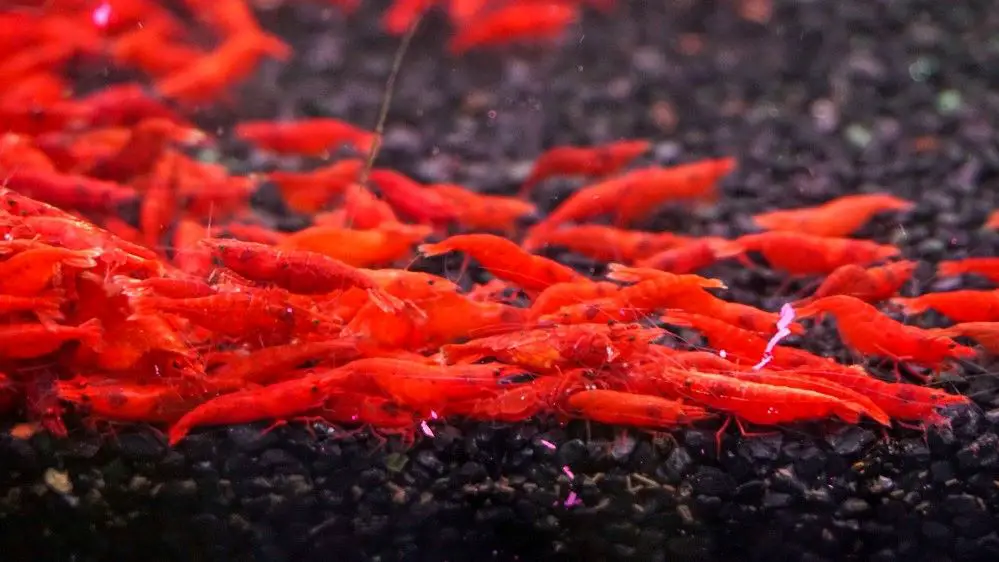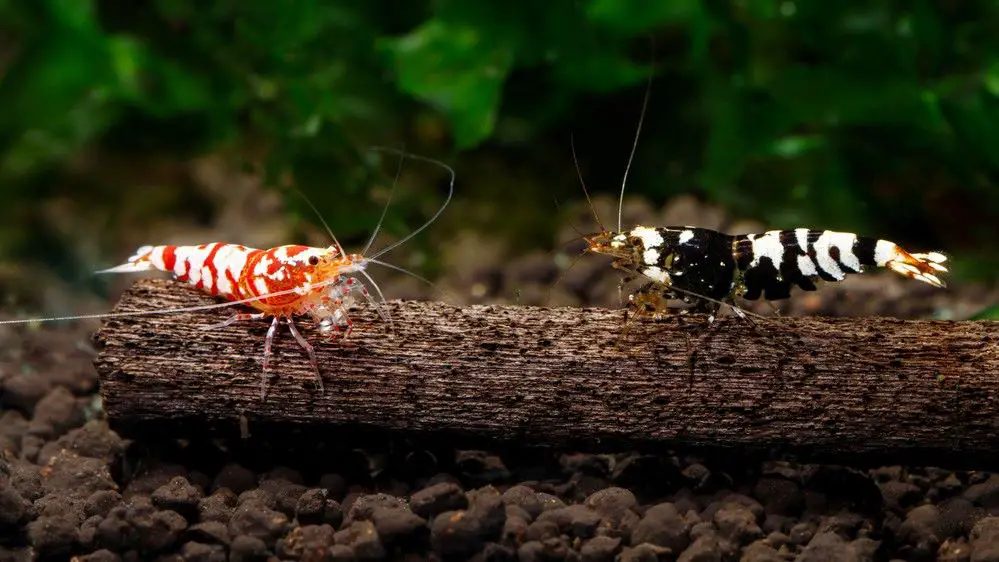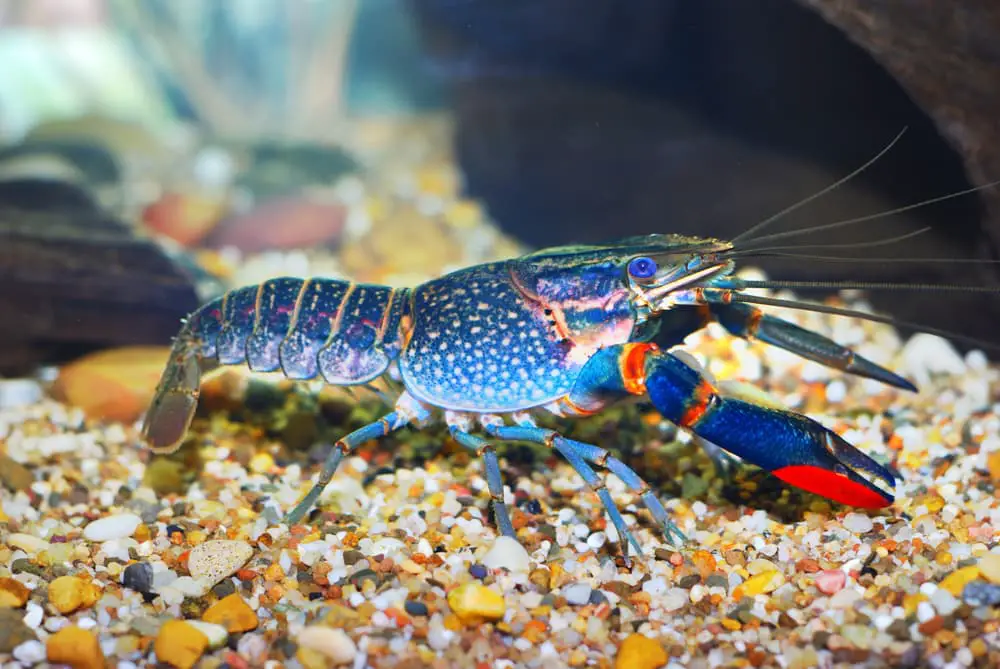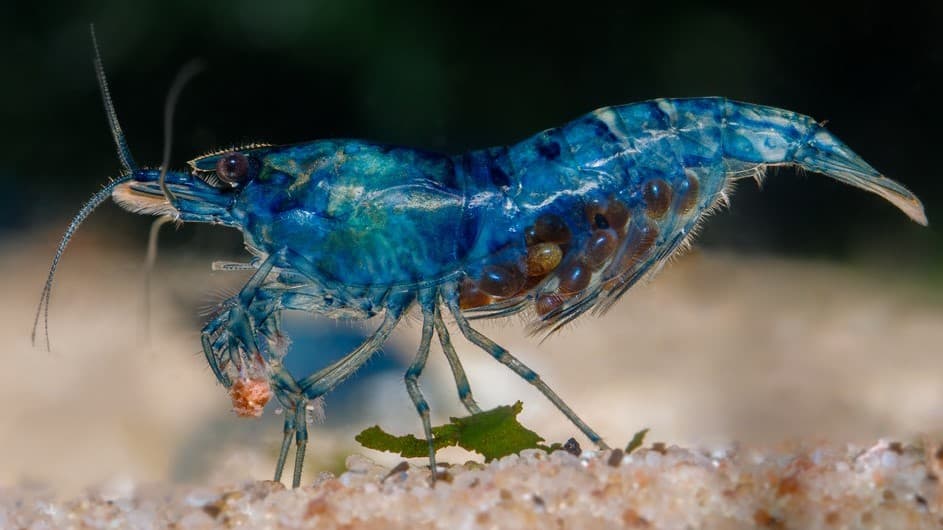The best substrate for a shrimp tank often depends on the shrimp species, but active substrates, gravel, and river sand are top choices.
often depends on the shrimp species, but active substrates, gravel, and river sand are top choices.
As a shrimp keeper for over a decade, I’ve seen the impact of substrate choice on the health and happiness of my shrimp. I remember when I first started crystal red shrimp for example, I used gravel from my local pet store.
for example, I used gravel from my local pet store.
It worked, but I noticed my shrimp weren’t as vibrant or active as they could be and they never breed, I did some research and switched to ADA Aquasoil, and the difference was night and day.
My shrimp were happier, healthier, and their colors were more vibrant. Over the years, I’ve experimented with various substrates, from sand to specialized shrimp substrates. In this article, I’ll share my insights and experiences to help you choose the best substrate for your shrimp tank and species.
and species.

Substrates
Substrate plays a crucial role in the overall health of your shrimp tank . It’s not just about aesthetics, although a well-chosen substrate can indeed enhance the visual appeal of your tank. The substrate serves several vital functions that contribute to a thriving shrimp environment.
. It’s not just about aesthetics, although a well-chosen substrate can indeed enhance the visual appeal of your tank. The substrate serves several vital functions that contribute to a thriving shrimp environment.
Buffering Capacity and pH Stability
Certain substrates, known as active substrates, have the ability to alter the water chemistry in your tank. They can lower the pH and soften the water, creating conditions that are more conducive to the health and breeding of many shrimp species. This buffering capacity helps maintain a stable, slightly acidic pH, which is particularly beneficial for Caridina shrimp species like Crystal Red Shrimp and Taiwan Bee Shrimp.
Shrimp and Taiwan Bee Shrimp.
Nutrient Supply for Plants
If you’re planning to have live plants in your shrimp tank , the substrate becomes even more critical. Certain substrates are rich in essential nutrients that plants need to grow. They can provide a constant supply of nutrients to the plant roots, promoting lush, healthy growth. This not only creates a beautiful planted tank but also provides additional cover and foraging areas for your shrimp
, the substrate becomes even more critical. Certain substrates are rich in essential nutrients that plants need to grow. They can provide a constant supply of nutrients to the plant roots, promoting lush, healthy growth. This not only creates a beautiful planted tank but also provides additional cover and foraging areas for your shrimp .
.
Biological Filtration
The substrate serves as a home for beneficial bacteria. These bacteria play a crucial role in the nitrogen cycle, converting harmful waste products like ammonia and nitrite into less harmful nitrate . A substrate with a high cation exchange capacity (CEC) can attract and hold onto these waste products, making them available for the bacteria to process.
. A substrate with a high cation exchange capacity (CEC) can attract and hold onto these waste products, making them available for the bacteria to process.
Comfort and Foraging
Shrimp are bottom dwellers and spend a lot of their time foraging in the substrate. They sift through the substrate, looking for bits of food and biofilm to eat. A substrate that is comfortable for the shrimp to walk on and dig through can contribute to their overall happiness and well-being.
The substrate is more than just a decorative element in your shrimp tank. It’s a functional part of the ecosystem that can significantly impact the health and happiness of your shrimp. Choosing the right substrate is, therefore, a decision that should be made with care and consideration.

Different Types of Substrates
When it comes to choosing a substrate for your shrimp tank, there are several types to consider. Each type has its own set of characteristics, benefits, and potential drawbacks. Let’s dive in and explore these different types of substrates.
Gravel
Gravel is a common choice for many aquariums, including shrimp tanks. It’s readily available, comes in a variety of colors and sizes, and is relatively inexpensive. However, it doesn’t offer much in terms of nutrient content for plants or buffering capacity for water chemistry. It’s also harder for shrimp to sift through compared to other substrates.
Sand
Sand is another option that’s popular in shrimp tanks. It’s finer than gravel, making it easier for shrimp to sift through while foraging. However, like gravel, it doesn’t provide any nutrients for plants or help with water chemistry. It can also compact over time, which can lead to dead spots where harmful gases can build up.
Active Substrates
Active substrates are specially designed for use in shrimp and planted tanks. They’re made from fired clay or volcanic ash and have a high cation exchange capacity (CEC), which allows them to absorb and release nutrients for plants. Active substrates also have a buffering capacity, meaning they can lower the pH and soften the water, creating ideal conditions for many shrimp species. Examples of active substrates include ADA Aquasoil and Akadama.
Inert Substrates
Inert substrates are those that don’t alter water chemistry or provide nutrients. They’re essentially neutral and include options like quartz sand or certain types of gravel. While they don’t offer the benefits of active substrates or soil , they can be a good choice if you’re keeping shrimp that prefer harder, more alkaline water, or if you’re using a separate method to fertilize your plants.
, they can be a good choice if you’re keeping shrimp that prefer harder, more alkaline water, or if you’re using a separate method to fertilize your plants.
The best substrate for your shrimp tank depends on several factors, including the type of shrimp you’re keeping, whether you have live plants, and your personal preferences. Each type of substrate has its own pros and cons, and understanding these can help you make an informed decision.

Benefits of an Active Substrate for Softwater Shrimp
Active substrates are a popular choice among shrimp keepers for several reasons. These substrates, which offer a range of benefits that can contribute to a thriving shrimp tank. Let’s explore these benefits in more detail.
Water Chemistry Regulation
One of the primary benefits of active substrates is their ability to regulate water chemistry. They can lower the pH and soften the water, creating conditions that are ideal for many shrimp species. This is particularly beneficial for Caridina shrimp species, which thrive in slightly acidic, soft water conditions. By maintaining a stable pH, active substrates can help reduce stress on your shrimp and promote healthier, more vibrant colors.
Nutrient Supply for Plants
Active substrates are rich in essential nutrients that plants need to grow. They can provide a constant supply of nutrients to the plant roots, promoting lush, healthy growth. This not only creates a beautiful planted tank but also provides additional cover and foraging areas for your shrimp. The high cation exchange capacity (CEC) of active substrates allows them to absorb and hold onto nutrients, making them readily available for plant roots.
Biological Filtration
Active substrates also contribute to biological filtration in your tank. They provide a home for beneficial bacteria, which play a crucial role in the nitrogen cycle. These bacteria convert harmful waste products like ammonia and nitrite into less harmful nitrate. The high CEC of active substrates allows them to attract and hold onto these waste products, making them available for the bacteria to process.
Comfort for Shrimp
Active substrates are typically made from fired clay or volcanic ash, which results in a soft, granular texture. This makes it comfortable for shrimp to walk on and dig through. It also makes it easier for shrimp to forage, as they can sift through the substrate to find bits of food and biofilm.
Active substrates offer a range of benefits for shrimp tanks, from regulating water chemistry to providing a nutrient-rich base for plants. While they may be more expensive than other types of substrates, the benefits they provide can make them a worthwhile investment for many shrimp keepers.

How to add Substrate to a Shrimp Tank
Installing substrate in your shrimp tank is a straightforward process, but it’s important to do it correctly to ensure the health and happiness of your shrimp. Here’s a step-by-step guide on how to properly install substrate in a shrimp tank.
Step 1: Choose the Right Substrate
The first step is to choose the right substrate for your shrimp tank. Consider the needs of your shrimp species, whether you’ll have live plants, and your personal preferences. Active substrates like ADA Aquasoil or Fluval Stratum are often recommended for shrimp tanks due to their benefits for water chemistry and plant growth.
Step 2: Rinse the Substrate (If Necessary)
Some substrates, like gravel or sand, need to be thoroughly rinsed before they’re added to the tank to remove dust and small particles. However, active substrates should not be rinsed, as this can wash away beneficial bacteria and nutrients. Always check the instructions on the substrate packaging to see if rinsing is recommended.
Step 3: Add the Substrate to the Tank
Start by adding a layer of substrate to the bottom of the tank. The depth of the substrate will depend on whether you’re planning to have live plants. For a shrimp-only tank, a depth of 1-2 inches is usually sufficient. For a planted tank, you might want a deeper substrate, around 2-3 inches, to provide ample room for plant roots.
Step 4: Shape the Substrate
Use a substrate spatula or a similar tool to shape the substrate. Many aquascapers prefer to have a higher substrate level at the back of the tank for a sense of depth and perspective. This is also a good time to create any hills or valleys in your substrate if you’re planning a more complex aquascape.
Step 5: Add Water Slowly
When you’re ready to add water to the tank, do so slowly to avoid disturbing the substrate. Place a plate or a piece of plastic on the substrate and pour the water onto this to dissipate the force of the water. Fill the tank halfway, then plant your plants if you’re using them. After planting, you can fill the rest of the tank.
Step 6: Cycle the Tank
Before adding your shrimp, it’s essential to cycle the tank to establish a colony of beneficial bacteria. This process can take several weeks, but it’s crucial for the health of your shrimp.
to establish a colony of beneficial bacteria. This process can take several weeks, but it’s crucial for the health of your shrimp.
Installing substrate in a shrimp tank is a relatively simple process, but it’s important to do it correctly. By choosing the right substrate, preparing it properly, and installing it with care, you can create a healthy and attractive environment for your shrimp.

Maintenance and Longevity of Substrates in Shrimp Tanks
Maintaining the substrate in your shrimp tank is an essential part of overall tank care. Proper maintenance can extend the longevity of the substrate and ensure it continues to provide the necessary benefits for your shrimp and plants. Let’s delve into the details of substrate maintenance and longevity.
Routine Maintenance
Regular maintenance of your substrate primarily involves siphoning off any visible waste or uneaten food during your routine water changes. This helps prevent the buildup of harmful substances that could negatively impact water quality. However, be careful not to disturb the substrate too much, especially if you’re using an active substrate or soil, as this could cloud your water or release trapped gases.
Avoid Overfeeding
Overfeeding your shrimp can lead to excess food sinking to the bottom and decaying in the substrate. This not only dirties the substrate but can also lead to poor water quality. Feed your shrimp only what they can consume in a few hours to prevent food from accumulating in the substrate.
Plant Care
If you have live plants in your tank, their roots will grow into the substrate. Occasionally, you may need to trim or prune your plants, which can disturb the substrate. Do this carefully to minimize disruption. If you’re using a nutrient-rich substrate, you may not need to add additional root tabs or fertilizers, but this depends on the specific plants you’re keeping.
Substrate Replacement
Over time, active substrates can lose their buffering capacity and nutrient content. Generally, active substrates should last for 1-2 years before they need to be replaced. However, this can vary depending on the specific substrate, the tank conditions, and how heavily the tank is stocked. When the substrate’s buffering capacity declines, you may notice a gradual increase in pH. This is usually a sign that it’s time to replace the substrate.
Replacement Process
Replacing substrate in an established tank can be a complex process, as it can cause significant disruption. It’s often recommended to set up a new tank with fresh substrate and move your shrimp and plants over, rather than trying to replace the substrate in the existing tank. This allows you to avoid sudden changes in water parameters that could stress your shrimp.
While substrates in shrimp tanks require some maintenance, they generally have a good lifespan, especially active substrates. Regular maintenance, careful feeding, and attentive plant care can all help extend the longevity of your substrate and keep your tank healthy and thriving.

No substrate option if the goal is to mass-breed shrimp-like neocaridina
Choosing to go without substrate, often referred to as a “bare-bottom” tank, is a viable option for shrimp keepers, particularly those who aim to mass-breed certain species like Neocaridina. This approach has its own set of advantages and considerations. Let’s delve into the details of using a no substrate option for mass-breeding shrimp.
Ease of Maintenance
One of the main advantages of a bare-bottom tank is the ease of maintenance. Without substrate, detritus and uneaten food cannot get trapped in the bottom layer, making it easier to see and remove. This can lead to better overall water quality, as there’s less chance for harmful substances to build up in the tank.
Breeding Considerations
Neocaridina shrimp, like the popular Cherry Shrimp, are hardy creatures that can adapt to a wide range of water parameters. They don’t require the specific water conditions that active substrates provide, making them suitable for a bare-bottom tank. The absence of substrate also makes it easier to observe the shrimp, including any berried (egg-carrying) females or newly hatched shrimplets.
Feeding and Foraging
Without substrate, shrimp will not be able to forage in the same way they would in a tank with substrate. This means you’ll need to provide enough food to ensure they’re getting the nutrients they need. Be careful not to overfeed, as uneaten food can quickly foul the water in a bare-bottom tank.
Aesthetics and Comfort
While a bare-bottom tank may not have the natural look that a substrate provides, it doesn’t necessarily mean it has to be devoid of decor. You can still add live plants (preferably ones that attach to rocks or driftwood, like Java Moss or Anubias), rocks, and other decorations to provide cover and climbing areas for your shrimp.
Temperature and pH Stability
Substrate can help with temperature and pH stability in a tank. Without it, you might find that your water parameters fluctuate more. Regular monitoring and adjustments will be necessary to maintain stable conditions.
A no substrate option can work well for mass-breeding Neocaridina shrimp, thanks to the ease of maintenance and the hardiness of these shrimp. However, it does require careful feeding and monitoring of water parameters to ensure the health and well-being of your shrimp.

Conclusion
Choosing the right substrate for your shrimp tank is a crucial decision that can significantly impact the health and well-being of your shrimp. From active substrates like ADA Aquasoil and Fluval Stratum, which offer benefits like pH buffering and nutrient supply for plants, to the simplicity of a bare-bottom tank for mass-breeding hardy Neocaridina, there’s a substrate option to suit every shrimp keeper’s needs. Remember, the best substrate for your shrimp tank depends on your specific circumstances, including the type of shrimp you’re keeping, whether you have live plants, and your personal preferences. If you need help navigating these choices or are unsure which substrate suits your needs, please don’t hesitate to reach out.
Happy Shrimp Keeping!
FAQ
Q. Do shrimp need sand or gravel? A. Shrimp do not specifically need sand or gravel, but they do benefit from a substrate that they can forage in. Both sand and gravel can serve this purpose, but many shrimp keepers prefer finer substrates, like sand or specialized shrimp substrates, which are easier for shrimp to sift through.
Q. Is sand substrate better for shrimp? A. Sand can be a good choice for a shrimp substrate as it’s easy for shrimp to sift through when foraging. However, it doesn’t provide any nutrients for plants or help with water chemistry. Active substrates, like ADA Aquasoil or Fluval Stratum, are often recommended for shrimp tanks due to their additional benefits.
Q. What substrate is best for Caridina shrimp? A. Caridina shrimp, such as Crystal Red Shrimp and Taiwan Bee Shrimp, thrive in slightly acidic, soft water conditions. Therefore, active substrates like ADA Aquasoil or Fluval Stratum, which lower the pH and soften the water, are often considered the best choice for Caridina shrimp.
Q. What is the best rock for cherry shrimp? A. Cherry shrimp aren’t particularly picky about the type of rock in their tank. However, rocks that provide plenty of surface area for biofilm to grow, like lava rock or dragon stone, can be beneficial as they offer additional foraging opportunities.
Q. What is the best rock for shrimp? A. The best rock for shrimp is one that provides plenty of surface area for biofilm to grow, as this provides a natural food source for the shrimp. Lava rock, dragon stone, and seiryu stone are all popular choices.
Q. What do shrimp like in their tank? A. Shrimp like a tank that provides plenty of hiding spots and foraging opportunities. This can include live plants, rocks, driftwood, and a suitable substrate. They also prefer stable water parameters, with the specific parameters depending on the shrimp species.
Q. Do shrimp need mineral rocks? A. Mineral rocks, like mineral balls, can be beneficial for shrimp as they slowly release minerals into the water that help with shrimp’s molting process. However, they’re not strictly necessary if your water already contains sufficient minerals.
Q. Do shrimp need moss balls? A. Shrimp don’t specifically need moss balls, but they can be a beneficial addition to a shrimp tank. Moss balls provide additional surface area for biofilm to grow, offering more foraging opportunities for shrimp.
Q. Do Amano shrimp need sand? A. Amano shrimp
need sand? A. Amano shrimp can do well with any type of substrate, including sand. They are hardy shrimp that are not particularly sensitive to water parameters, so the choice of substrate can be based on your personal preference and whether you have live plants in the tank.
can do well with any type of substrate, including sand. They are hardy shrimp that are not particularly sensitive to water parameters, so the choice of substrate can be based on your personal preference and whether you have live plants in the tank.
Q. Can shrimp hide in sand? A. Shrimp can burrow into sand to some extent, but they generally prefer to hide in plants, rocks, or other decor rather than in the substrate.
Q. How deep should sand substrate be? A. The depth of a sand substrate can depend on whether you have live plants in your tank. For a shrimp-only tank, a depth of 1-2 inches is usually sufficient. For a planted tank, you might want a deeper substrate, around 2-3 inches, to provide ample room for plant roots.
Q. Do shrimp need special substrate? A. Shrimp don’t necessarily need a special substrate, but certain substrates can provide benefits for shrimp. Active substrates, for example, can help maintain a stable, slightly acidic pH, which is beneficial for manyshrimp species. However, hardy shrimp like Neocaridina can do well with a variety of substrates, including sand, gravel, or even in a bare-bottom tank.
Q. Is aqua soil safe for shrimp? A. Yes, aqua soil is safe for shrimp. In fact, it’s often recommended for shrimp tanks due to its ability to lower the pH and soften the water, creating ideal conditions for many shrimp species. It also provides nutrients for live plants, which can contribute to a healthy and balanced shrimp tank.
Q. Do shrimp need aquasoil? A. Shrimp don’t specifically need aquasoil, but it can provide several benefits in a shrimp tank. It helps maintain a stable, slightly acidic pH and provides nutrients for plants, both of which can contribute to a healthy environment for shrimp. However, the choice of substrate should be based on the specific needs of your shrimp species, whether you have live plants, and your personal preferences.
